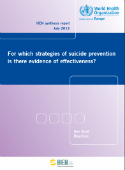For which strategies of suicide prevention is there evidence of effectiveness?

Download
Summary
The issue
Suicide is a serious global public health problem. Despite substantial efforts in suicide prevention, it remains unclear which interventions are effective in preventing suicide. The objective of this report is to synthesize research findings from systematic reviews to address two questions:
- What types of suicide preventive intervention have been evaluated in the published research?
- Which suicide preventive interventions have good-quality evidence to support them?
Findings
Around 34 types of suicide preventive interventions were evaluated in the published systematic reviews, which covered the whole spectrum of suicide prevention efforts from prevention through to treatment and maintenance. More than half of these interventions fell into the domain of treatment and maintenance rather than prevention. This is not surprising given that the motivation may be to “treat” or reduce risk factors such as depression or mental illness.
Evidence from seven systematic reviews (rated as “average” or “good” in relation to their methodological quality) indicated that some interventions may be promising.
- School-based suicide prevention programmes that focused on behavioural change and coping strategies in the general school population and skill training and social support for at-risk students had beneficial effects on intermediate outcomes, such as suicidal tendencies and risk factors for suicide; however, the effect of these interventions on suicide rates is not known.
- There was limited evidence that multifaceted suicide prevention programmes based on risk factor identification and educational and organizational changes reduced the rates of suicide and attempted suicide among military personnel.
- Restriction of access to lethal means (e.g. firearms and pharmacological agents) may reduce the rate of cause-specific suicide in the general population, but its effect on the overall suicide rate was unclear.
- The administration of lithium reduced the risk of suicide and deliberate self-harm in patients with mood disorders.
- Psychosocial and pharmacological treatments, such as problem-solving therapy, provision of a card for emergency contact, cognitive behavioural therapy and administration of flupenthixol, were promising in reducing rates of repeated selfharm among suicide attempters.
Policy considerations
Although the effectiveness of a variety of suicide preventive interventions has been examined in the primary research, not all of these studies are represented in the systematic review literature. In addition, many interventions that are currently in use have not yet been evaluated in primary research.
Based on the limited evidence to date, some interventions aimed at specific populations showed some benefit for intermediate outcomes, but few of the reviews demonstrated direct effects on mortality rates. Owing to the limited evidence and the heterogeneity of the interventions, it was not possible to determine if one single intervention was more effective than another. Local factors, such as population characteristics and the social, cultural and socioeconomic context, need to be taken into consideration when attempting to generalize these findings to other populations.
Suicide is a result of complex interactions among various risk factors and protective influences. Consequently, a strategy including a combination of suicide prevention approaches addressing different risk factors at various levels will be required. When implementing a new strategy, an evaluation framework should be established to help to determine its effectiveness.



